Our Matrons & Police Women
by Edward J. "Ed" Steenberg, Saint Paul Police Historical Society
Please note as you read this document that related female employees are shown in bold script and that certain abbreviated personnel data is provided in footnotes.
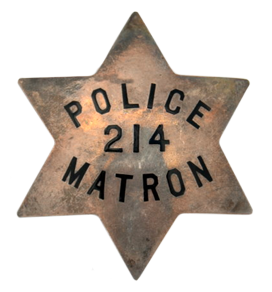
Although police matrons had already worked at the Central Station and at the City Workhouse for several decades, on January 01, 1913, the Saint Paul Police Department added the first 'functional' policewomen to the force, holding the official title of "Police Inspector". The ratification of the Woman Suffrage Amendment on August 18, 1920, enabled them to become authoritative sworn officers with the same arrest powers as their male policing counterparts for the first time, but the use of women in uniform did not take place in Saint Paul until September 08, 1975.
Long before women were commonly employed as fully sworn police officers, many police agencies employed women with limited powers to search and attend to female prisoners and to deal with matters specifically affecting women and children. These female officers were often known as "police matrons" and were mostly employed in agency lockups (jails) or workhouses. Appointments of women in law enforcement, no matter what the title, came about only after intense pressure and lobbying by various benevolent and charitable groups, moves that created a great deal of resistance in the traditionally all-male policing establishment.
Because city lockups lacked separate accommodations for female prisoners in Saint Paul's early years, women, young and old, were held at the House of the Good Shepherd, a local refuge operated by the Contemplative Sisters of the Good Shepherd. In the beginning, four Catholic sisters conducted their work as matrons in an eight-room cottage at Smith Avenue and Leech Street starting on December 15, 1868, under an arrangement with the common (city) council and the police department "to accept and hopefully to rehabilitate female offenders rather than sentencing them to serve time in the common jail." By the end of the first month, eighteen such wards had entered the facility. The Contemplative Sisters' primary mission was to serve the needs of the homeless, wayward, and criminal girls and women.
To accomplish that task they developed two distinct programs: the first, initially called the "Preservation Program", was the care of girls who came from failing homes. The second, called the "Penitent Program", served former prostitutes, delinquent girls, or others convicted of misdemeanors subjecting them to imprisonment under the charter and ordinances of the city. Such commitment was pursuant to an edict of the city declaring the House of the Good Shepherd to be a "workhouse for female prisoners." At the conclusion of their court-ordered stay, most were released outright, however, they had the option to remain with the sisters in a semi-religious status, assisting with the service mission.
As the refuge outgrew its original site, they moved into the former Baldwin School building on Wilkin Street overlooking the Mississippi River. Of the first one thousand girls to enter the House of the Good Shepherd, about forty percent came from the courts, thirty percent came from their families, twenty percent came voluntarily and ten percent came from religious organizations or through other referrals. As we moved into the twentieth century, the majority of referrals continued to come from municipal courts and family members. As the house of refuge and correction grew it opened a number of branch institutions, including one in Minneapolis, and as far west as Seattle. Although the sisters were not official employees of the city, they were contract agents (police matrons) thereof, and it should be noted that an ordinance was passed on October 07, 1869, specifically designating the charitable institution known as the House of the Good Shepherd as the "workhouse" for female prisoners of the city.
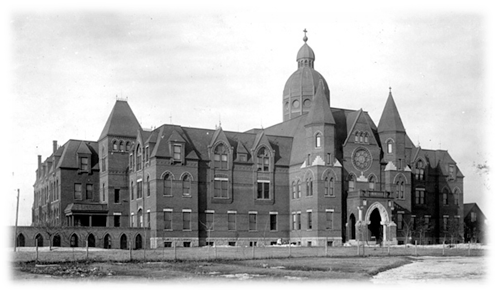
House of the Good Shepherd c. 1887
Said to be the oldest such reformation institution for females in Minnesota, the facility moved to a massive Gothic sanctuary, complete with three tall towers and a large dome, in the spring of 1887 on a thirteen-acre site at 931 Blair Avenue. This writer made many a trip to the Blair Avenue refuge in the mid-1960s, when the Ramsey County Juvenile Detention Center (JDC) was full, or when unable to transport a wayward adolescent to her own home, for whatever reason. No longer used as a female house of correction, the renamed Home of the Good Shepherd is now located at 5104 Hodgson Road in North Oaks (Ramsey County) and continues to work with females in need.
Starting out as an initiative pushed by Saint Paul City Attorney Isaac V.D. Heard during the same era as the House of the Good Shepherd, Minnesota's first experiment in juvenile justice, the State Reform School, originally called the House of Refuge of the State of Minnesota, operated out on the "open prairie" in Rose Township (later to become a part of Saint Paul) from January 1868 to 1891 on the grounds of present-day Concordia University and Central High School. The reform school functioned there for twenty-three years, growing from a first-year class of thirty-nine to classes of over three hundred inmates and from a single building, to a complex of dormitories, workshops, and outbuildings. During that time period, over 1,250 adolescents, most of them boys, were committed to the institution, mostly for petty crimes and "incorrigibility."
Outgrowing its Saint Paul campus and tired of the endless catch-up improvements of an aging facility, the state created a relocation commission in 1886, and Red Wing won a statewide competition over Hastings, Shakopee, Buffalo Lake, and Farmington. The move began to the new facility on a 450-acre site at the outskirts of Red Wing in the summer of 1891 and was completed by November. In 1895, the name was changed to the State Training School for Boys and Girls.
The aforementioned House of Refuge, authorized by the Minnesota legislature in 1866, functioned to accomplish two goals: first to keep boys (admitted no older than age sixteen) and girls (admitted no older than age fifteen) out of adult jails and prisons; and the second, to provide education, shelter, and training for young people found guilty of crimes or neglected by incompetent parents. As with the cottage run by the Contemplative Sisters of the Good Shepherd, the State Reform School utilized matrons in their staffing needs. Although originally a city initiative, the reform school soon developed into a state institution. The workers therein, including the matrons, were therefore state employees, not that of the city.
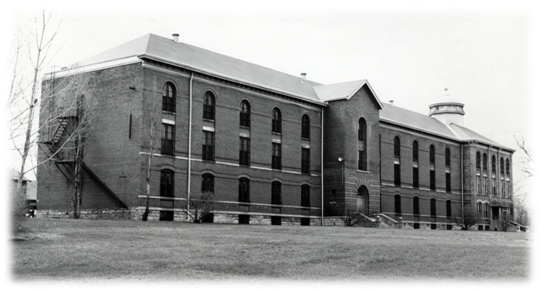
Saint Paul City Workhouse c. 1940
In April of 1881, when the development of Como Park was delayed by economic conditions and before a park board was in place to protect park interests, Saint Paul granted forty-acres of parkland to the workhouse board for the construction of a new workhouse on land southwest of what is now the intersection of North Lexington Parkway and Como Avenue. Locating a workhouse on unused parkland on the rural outskirts of the city seemed a prudent idea at the time. The contract for the building was granted to Timothy Reardon, the lowest bidder, for $23,500 and for seventy-eight years, from 1882 to 1960, the Saint Paul City (later County) Workhouse occupied a portion of Como Park. Its' red brick, three-story building stood where the Como Regional Park Pool is now located.
The building opened in February of 1883 and admitted its first inmate, the "notorious" David Hoar, who was sentenced to sixty days for drunkenness, not for the first time or the last. The building initially had thirty two-person cells, an assembly room, and additional single cells for solitary confinement in the basement. City records indicate that the workhouse complex grew to include enough room for 350 prisoners in 158 cells, one of the largest such institutions in the region. Early workhouse staff included a superintendent and secretary, an on-call physician, a chief jailer, guards (one of whom was also a barber), a teamster, two cooks, and of course matrons. Their charges were largely supposed to plow the ground and grade the avenues around Lake Como. In addition to working in the park and operating a twenty-acre farm on the workhouse grounds, inmates toiled in the workhouse's broom factory, as well as the knitting, shoe and tailor shops, the laundry and they also did other heavy labor.
Most were first-time offenders convicted of drunkenness, vagrancy, larceny and disorderly conduct. A few regulars highlighted in a 1904 newspaper article earned nicknames like "Repeater Pete" Heaney, age 22, sentenced twenty-nine times by then, or Hannah Albrecht, age 55, "The Lady of the Lake," then serving her thirty-eighth sentence.
The workhouse was a self-sustaining institution. Soon after it opened, inmates helped build an on-site residence for the workhouse superintendent and two additions to the already-too-small facility. Woodland was promptly cleared for the aforementioned farm and garden.
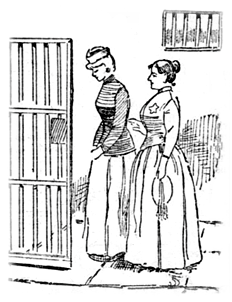
One of the early matrons of the city workhouse, Miss Theresa N. Walsh1, was born in County Dublin, Ireland, on July 29, 1838. At fifteen years of age she accompanied her parents to the United States and to Saint Paul. She received her appointment as police matron at the city workhouse in about April of 1896. A report of the city comptroller indicates Miss Walsh's salary at the time was $30 a month, less than half the wages of a patrolman/guard conducting similar duties.
The slow move out of Como Park began when the workhouse first rented farmland outside the city in 1923. Nineteen years later, it purchased 239 acres in Maplewood and finally, in 1958, groundbreaking for a new facility began there. In 1960, the old workhouse, described in a Pioneer Press article as "ancient, unloved and unlovely," was torn down.
At the request of various charitable and benevolent institutions in the city and because of obvious needs, a resolution was passed unanimously by the common council of Saint Paul stating that the mayor was authorized to appoint a matron at the central police headquarters. The police matron was to receive as compensation the sum of fifty dollars per month to be paid out of the police fund. The resolution was adopted by the board of aldermen on May 06, 1892, by the full assembly on May 10, 1892, with final approval given on May 12, 1892.2
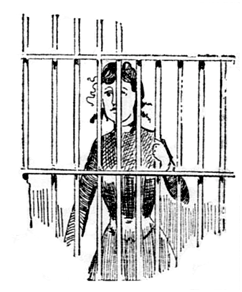
Bridget T. Cummings3, widow of Michael J. Cummings, a native of Saint Paul, was appointed Saint Paul's first police matron with an assignment outside of the city workhouse on May 15, 1892. She was removed from service on November 10th of the same year over a payroll misunderstanding (probable political standing) but was reappointed on June 25, 1894, and retired on September 18, 1906. She was considered exceptionally qualified for the position. Holding the slot while Mrs. Cummings was gone, was Hattie A. Walker4. She was appointed police matron on May 24, 1893, after working for four years (1889-1893) at the Stillwater State Prison. Mrs. Walker resigned on June 25, 1894, when Mrs. Cummings returned to work. Reports from the city comptroller indicate that while working as a police matron, Mrs. Walker, also, earned $50 a month.
The official report of Chief Michael N. Goss for the year ending December 31, 1898, included his urgent recommendation that a new central station and lockup, with modern improvements, be built near the city hall and courthouse. "The all too frequent escapes from cells at the present one should be conclusive evidence that a new building is badly needed. There is a constant demand for more room and it seems especially necessary that a quarters be provided for the police matron, Mrs. Cummings, who is now available only if at home when called. She occupies a flat of rooms immediately adjacent to headquarters together with her four children, and receives a salary of $50 a month."

While Mrs. Cummings was the matron in charge at the central station in Saint Paul, the women's room in the lockup, sometimes referred to as the matron's apartments, was on the second floor and consisted of one long, well-lighted room. Within that were four individual cells. Cummings usually did not lock women into the cells but gave them the freedom of the larger room, except for drunks whom she did lock up into the individual cells until they sobered up. All the food her charges ate was prepared by the matron herself, who had an apartment of her own next to the jail. Mrs. Cummings was allowed fourteen cents for each meal which consisted, as a rule, of coffee and bread and butter. The arrests of women during the day were mostly for shoplifting, stealing, and disorderly conduct. Arrests of women at night were mostly for "street strolling" and disorderly conduct. Police Matron Cummings' first night on the job included three females confined.
When police matrons began to be hired in the mid-nineteenth century they could easily have been given the official designation and title of policewomen. But society was not yet ready to accept such a change in the role of the feminine gender. The women who entered the police service during that period were called matrons to disassociate them from "real" police officers. When females called policewomen were finally hired in the twentieth century, it was with very limited and circumscribed duties. The title could have easily been used earlier and applied to the matrons, but it took scores of years of agitation and lobbying by women before society would, not without great reluctance, concede and use the term that should have been first applied years earlier.
An observation was made by suffragist Isabella H. Beecher and reported in an 1887 St. Paul Daily Globe newspaper item wherein she proposed a novel reform plan, to "put women on the police force." 5
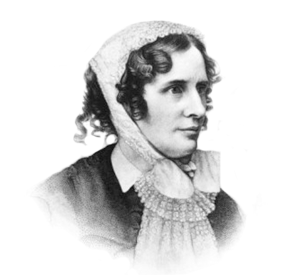
Suffragist Isabella H. Beecher
On December 17, 1912, Ordinance Number 3098 was passed by the common council of the City of Saint Paul authorizing the mayor to appoint two women to act as inspectors in picture shows, dance halls, public parks, pool-rooms, restaurants, saloons, and other places of amusement and recreation. It was also the duty of the inspectors to patrol the streets at night and take all proper means to keep young girls from temptation and evil associations, and to take any complaint to the nearest police officer or to the Municipal Court of the violation of any laws or ordinances affecting the welfare or morals of women and girls and all minors. Although they did not wear a uniform the ordinance required the inspectors, while on duty, to wear a badge or other device on which was inscribed the words "Public Welfare Department". They were not armed, nor did they have arrest authority.
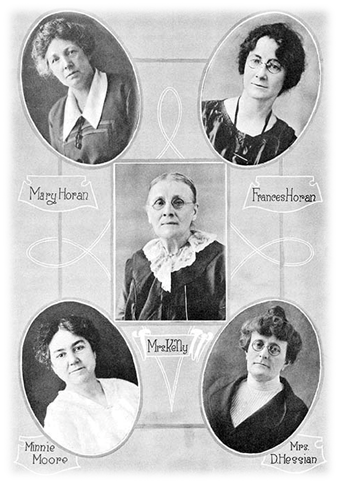 That decree opened the door for the hiring of the first functional policewomen on the force. At the time, many people, especially women's organizations, were concerned about the welfare of the city's women and children. They also were aware that other police departments around the country had added women. As a result, Margaret J. Kelly6 and Minnie H. Moore7 were appointed to the Saint Paul Police Department on January 01, 1913. And yes, departmental personnel records do document Kelly and Moore as police employees. The ordinance was amended in December of the same year to include the hiring of a third inspector.
That decree opened the door for the hiring of the first functional policewomen on the force. At the time, many people, especially women's organizations, were concerned about the welfare of the city's women and children. They also were aware that other police departments around the country had added women. As a result, Margaret J. Kelly6 and Minnie H. Moore7 were appointed to the Saint Paul Police Department on January 01, 1913. And yes, departmental personnel records do document Kelly and Moore as police employees. The ordinance was amended in December of the same year to include the hiring of a third inspector.
Officially, Kelly and Moore received the title of "Police Inspector" but were called policewomen, even by Mayor Herbert P. Keller8 and The New York Times. While exploring the role of women in police work, Saint Paul had solicited a legal opinion in 1912. The city attorney responded: "Women, while having the right to vote for school and library offices, and to hold such offices9, are not legal voters as that term is used in the statutes. Women therefore are not eligible to hold public office of policeman, patrolman, or detective or any other office of a similar nature with authority to make arrests." Even so, Kelly and Moore performed their jobs with determined professionalism. During their first year, they chased women and children out of saloons, monitored proper behavior in dance halls and reported on scandalous movies in the new theaters. They also visited area schools, hotels, factories and hospitals, always checking on the welfare of women and children. Kelly and Moore were so successful in their first year that Minerva A. "Minnie" Hessian10 was hired on January 01, 1914, as the third inspector.
Initially, there was strong opposition among policemen to the hiring of female officers, no matter what the title. However, this overt opposition gradually faded, at least on the surface, and the hiring of policewomen spread. By 1915, it was reported by the United States Census Bureau that twenty-five cities employed policewomen who were paid from police appropriations, including that of Minneapolis (2) and Saint Paul (3). In addition, cities continued to employ police matrons.
The Nineteenth Amendment to the United States Constitution granted women the right to vote, prohibiting any United States citizen to be denied the right to vote based on sex. The Minnesota state legislature approved the amendment on September 11, 191911, and it was ratified nationwide on August 18, 1920. In Saint Paul, not only did it give women the right to vote, but it also gave them the right to hold public office, enabling females to become authorative sworn police officers, contrary the aforementioned legal opinion by the city attorney.
It should also be noted that several additional laws passed in the 1920s and 1930s allowed women to be appointed to various related bodies of public service. A Minnesota state statute was passed and approved on April 19, 1921, allowing women to be appointed as special deputy sheriffs and/or bailiffs in certain cases.12 Likewise, gender qualification was eliminated from jury service on the same date13.
The February 1921 issue of The Policeman's News reported that the policewomen of Saint Paul (Kelly, Moore, and Hessian) made 7,455 investigations for that year, including 1,709 cases against girls, 1,450 family calls, 926 inspections at dance halls, 872 visits to theaters and amusement places, 770 cases against boys, 625 visits to hotels and restaurants, 491 court cases, 412 investigations for other cities, 154 visits to pool rooms, and 46 inspections at former saloons and wine rooms.
Although we have several older departmental manuals in our Historical Society collection, the 1923 version is the first one that we could find that contains rules and regulations for both the "Matron" and the "Policewomen". It was deemed neglect of duty for any member of the agency to be unfamiliar with the rules and regulations as found in the manual and the legal powers and duties of his or her position as defined therein. The Book of Rules was to be carried at all times by members of the force while on active duty. A copy, including the applicable rules and regulations, can be found on our website's "SPPD History" page, along with several other related documents.

Rules and Regulations
Bureau of Police 1923
Moving further into the twentieth century, records indicate that a large number police matrons had been hired by the Saint Paul Police Department, mainly being assigned to the city workhouse but later to include the central station lockup. As Ramsey County took over the responsibility of the workhouse, many of the matrons were reassigned to county employment, although some were upgraded to policewoman status and stayed with the city's police department.
One of the police matrons that made such a change to policewoman, Margaret J. Byrne14, was appointed police matron at central station by Chief Thomas Archibald "Tom" Brown on October 01, 1930. On May 16, 1932, her title was changed to policewoman by the same chief. Byrne was only the fifth woman to hold that new title. The fourth was her mother, Mary A. Smith15, who had been hired as a policewoman on September 01, 1923, and retired with a disability pension on April 01, 1943. Upon reaching the compulsory retirement age of sixty-five on April 24, 1953, Margaret Byrne said, "when I started, we did everything. We roamed through bars, dance halls, even picked up women solicitors. We'd throw them in jail. Then the emphasis shifted to juveniles. And during the more recent years we concentrated almost entirely on girls under eighteen."
Because of the growing number of women in Saint Paul's policing service, in 1930 a reorganization took place in what had become known as the policewomen division, with a female supervisor being placed in charge. The Annual Report for that year showed three policewomen in the department's table-of-organization, along with three police matrons working at the central station lockup. Maximum pay for the policewomen was $142.60 a month, while the matrons earned $127.90. Women did not serve in large numbers, however, for several more decades. Both Minnie H. Moore and Minerva A. Hessian (above) went on to become supervisors in the policewomen unit. Hessian retired on July 01, 1935, and Moore on September 01, 1940.
The Annual Report of the Bureau of Police for the year 1930 indicates that the women's division, under Minnie H. More, conducted 3,103 miscellaneous investigations, worked 1,289 cases against girls, answered 1,241 family calls, visited 323 dance halls, investigated 307 cases against boys, attended 234 court cases, visited 228 theaters and amusement places, investigated 197 cases for other cities, made 118 criminal arrests, and investigated 9 cases involving hotels and restaurants, for a total of 7,049 active cases. Quite a case load for three policewomen.
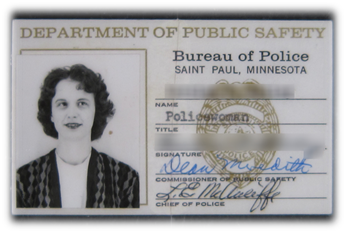
On July 17, 1961, Carolen F. Bailey16 was hired as a policewoman, joining Graciela M. Flores17, who had been hired on July 13, 1953, and Dorothy M. Freischel18, hired on October 01, 1954. I mention them only because they were my contemporaries. Although Flores and Freischel were normally assigned to work in what was then considered traditional female policing areas of protecting women and youth from society's ills, and handling juvenile cases and runaways, Bailey spent many years as an investigator in the Robbery/Sex/Homicide Unit. But none of them worked on the streets in uniform at that time. The three were promoted to policewoman sergeant on December 25, 1971 and Bailey went on to be promoted to the standard police lieutenant classification on May 26, 1985. Her first assignment was as a team commander, a uniformed position. Bailey broke the glass ceiling within the department, benefiting all future women police officers wishing to attain command level assignments. Records indicate that at least a dozen females were appointed as "Police Inspectors" or "Policewomen" in the department from those first hires of Kelly and Moore in 1913, through that of Bailey in 1961.
Two factors taking place in the 1970s contributed to a change in sworn officer demographics in Saint Paul for decades to come. The first was a discriminatory hiring practice suit filed in Federal District Court in Saint Paul against the Saint Paul Police Department and the Civil Service Bureau on March 01, 1972,19 by five black candidates for the position of patrolman.
After a great deal of mediation between the plaintiff's and defendant's attorneys, a plan was worked out to the satisfaction of all concerned parties and certified by United States District Court Judge Miles W. Lord20.
With the court's approval, a date of June 01, 1974, was set for the next police officer examination, with subsequent hires to be as nondiscriminatory as possible. The Saint Paul Police Department started its court mandated recruit academy on September 08, 1975, with forty-three recruits, including nine Black males, one Black female (out of over 265 female applicants), and one Hispanic male. What started out as a Black discrimination case, had developed into a suit including all individuals "protected" by the United States federal anti-discrimination law under the Civil Rights Act of 1964.21 It should be noted that on March 24, 1972, Title VII of the Civil Rights Act was amended, outlawing gender discrimination in government agencies, including police departments ["Equal Employment Opportunity Act of 1972"].
The second factor took place at about the same time (1974), when the department received a federal grant to fund an experiment to evaluate how female uniformed officers would perform on the street when given the same duties as their male counterparts. The women were to be assigned to regular district squads and were expected to carry identical call loads as the male officers. On September 08, 1975, (see above) Deborah L. Montgomery22 became the first female "Police Officer" recruited, hired and trained in the department through the traditional police academy process. She succeeded in performing the duties of her male counterparts and set the precedent for women seeking uniformed police officer careers in the Saint Paul Police Department. Montgomery went on to become a Senior Commander in the Saint Paul Police Department, an Assistant Commissioner of the Minnesota Department of Public Safety, a Saint Paul City Council member, and today, teaches in one of the local university law enforcement programs.
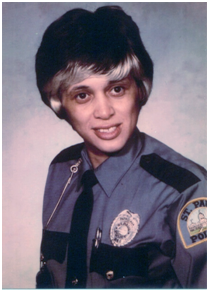
Deborah L. Montgomery
Of interesting note, the aforementioned discriminatory hiring practice suit wasn't the first such complaint lodged against the Saint Paul Police Department and the city of Saint Paul. In February of 1858, the common council, acting as the Police Commission, filed a written grievance with the mayor alleging that the police demographics at the time consisted of one chief and eleven patrolmen; six Irish officers, three American officers and two French officers, but no Germans. They insisted that some of the officers be dismissed, and replaced by German candidates. The mayor's response: "I do the hiring. I do the firing." No change was forthcoming.
No more "Matrons", no more "Policewomen", and no more "Patrolmen" in the Saintly City. The Saint Paul Civil Service job classification title of "Patrolman" changed to "Police Officer" on May 06, 1974. As we moved into 2019, about fifteen percent of Saint Paul's sworn officers were female (95 of 640), including forty-two supervisors and/or command staff. Of the female police managers, one was an assistant chief of police and one was a deputy chief of police. Today, the mayor doesn't do the hiring. Nor does he do the firing. The assistant chief of police mentioned, referrers to Kathleen A. Wuorinen23 who retired on March 31, 2019, after more than 30 years with the Saint Paul Police Department. Wuorinen served as the city's first female police chief in 2016, when she was appointed on an interim basis prior to the current chief's appointment. She had previously been a Ramsey County Deputy Sheriff. But Saint Paul's example is but the tip of the iceberg when considering the number of women who have reached the police community's upper echelons in Minnesota.
The Police Matron badge issued to Lillian A. Carter24 can be seen in the Saint Paul Police Museum. Appointed on November 14, 1940, she was honored by Mayor Charles P. McCarty in 1971 for 30 years of combined service to the Saint Paul Police Department and Ramsey County.
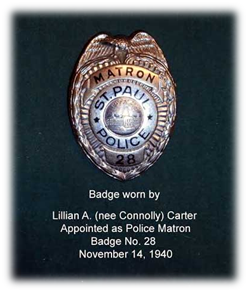
1 Theresa N. Walsh was appointed Police Matron at the City Workhouse (Como Park) in about April of 1896 and died in Saint Paul on July 05, 1915. Census records indicate that she was still employed at the Workhouse at least until 1905.
2 "The Police Matron," St. Paul Daily Globe, May 07, 1892; Page 2 and "Official Publication of Ordinances Passed and Resolutions adopted by the Common Council of the City of Saint Paul," St. Paul Daily Globe, May 16, 1892; Page 6.
3 Bridget T. Cummings was appointed Police Matron in the Central Station on May 15, 1892; was removed from office on November 10, 1892; was reappointed on June 25, 1894; retired on September 18, 1906; and died in Saint Paul on January 01, 1927.
4 Hattie A. Walker was appointed Police Matron in the Central Station on May 24, 1893 and resigned on June 25, 1894.
5 "Stray Sunbeams," St. Paul Daily Globe, April 14, 1887; Page 4, Item 8. Isabella Holms Beecher Hooker (1822-1907) was a leader, lecturer and activist in the American suffragist movement.
6 Margaret J. Kelly was appointed Police Inspector at the Central Station on January 01, 1913; had a change in title to Policewoman in 1920; and died in Saint Paul on January 12, 1923, while on medical leave.
7 Minnie H. Moore was appointed Police Inspector at the Central Station on January 01, 1913; had a change in title to Policewoman in 1920; was appointed Women's Division Supervisor on May 15, 1931; returned to the position of Policewoman on July 01, 1932; and retired on September 01, 1940.
8 Municipal Journal, January 16, 1913; Volume 34, No. 3, Page 98.
9 Minnesota Session Laws - 1897 Regular Session; Chapter 175, Section 8 [H.F. No. 668].
10 Minerva A. "Minnie" Hessian was appointed Police Inspector at the Central Station on January 01, 1914; had a change in title to Policewoman in 1920; was appointed Women's Division Supervisor on July 01, 1932; and retired on July 01, 1935.
11 Minnesota Session Laws -1919 First Special Session; Joint Resolution No. 1 [H.F. No. 1].
12 Minnesota Session Laws - 1921 Regular Session, Chapter 369 [S.F. No. 506].
13 Minnesota Session Laws - 1921 Regular Session, Chapter 365 [S.F. No. 164].
14 Margaret J. Byrne was appointed Police Matron at the Central Station on October 01, 1930; had a change in title to Policewoman on May 16, 1932; and retired on April 24, 1953.
15 Mary A. Smith was appointed Policewoman on September 01, 1923; retired on a disability pension on April 01, 1943; and died in Saint Paul on October 29, 1946.
16 Carolen F. Bailey was appointed Policewoman on July 17, 1961; was promoted to Policewoman Sergeant on December 25, 1971; was promoted to Lieutenant on May 26, 1985; and retired on January 31, 1991. For an interview of Carolen F. Bailey go to our Saint Paul Police Historical Society website at www.spphs.com and click on Oral Histories" at the top of the page.
17 Graciela M. Flores was appointed Policewoman on July 13, 1953; was promoted to Policewoman Sergeant on December 25, 1971; and retired on July 30, 1976.
18 Dorothy M. Freischel was appointed Policewoman on October 01, 1954; was promoted to Policewomen Sergeant on December 25, 1971; and retired on October 19, 1979.
19 Griffin, Deputy Chief James S. "Blacks in the St. Paul Police and Fire Department 1885-1976"; E & J Inc., Publishers, 1978 (also found here).
20 Over four decades Miles W. Lord served as Minnesota attorney general, a U.S. attorney and a federal judge. He was dubbed the "people's judge" for rulings that protected women's health, minority rights and the environment.
21 The Civil Rights Act of 1964 is a landmark civil rights and U.S. labor law in the United States that outlaws discrimination based on race, color, religion, sex or national origin. It prohibits unequal application of voter registration requirements, racial segregation in schools, employment, and public accommodations.
22 Deborah L. Montgomery was appointed Police Officer on September 08, 1975; was promoted to Sergeant on November 08, 1987; was promoted to Lieutenant on May 29, 1998; was appointed Senior Commander on February 08, 2003; and retired on July 31, 2003. For an interview of Deborah L. Montgomery go to our Saint Paul Police Historical Society website at www.spphs.com and click on "Oral Histories" at the top of the page.
23 Kathleen A. Wuorinen was appointed Police Officer on September 19, 1988; was promoted to Sergeant on October 07, 1995; was appointed Inspector on March 15, 1997; was promoted to Commander on November 18, 2006; was appointed Assistant Chief of Police on July 03, 2010; was appointed Interim Chief of Police on May 07, 2016; returned to previous title of Assistant Chief of Police on July 01, 2016; and retired on March 31, 2019.
24 Lillian A. Carter was appointed Saint Paul Police Matron on November 14, 1940, but transferred to the Ramsey County Detentions & Corrections Authority as a Workhouse Matron on July 01, 1961.
